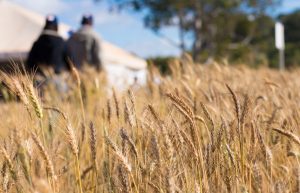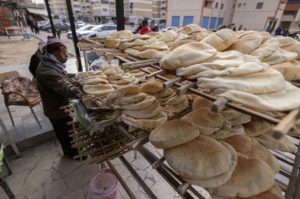São Paulo – Brazil seeks to improve its position in the wheat market. The country expects a significant increase in production in the coming years, which, in addition to making it self-sufficient, could generate greater export possibilities. “Brazilian production could increase, and I recognize business and exports could also increase in the same proportion,” said the general head of the Wheat Unit of the Brazilian Agricultural Research Corporation (Embrapa), Jorge Lemainski (pictured above).
Brazil could have a substantially bigger crop this year than last. Prospects are for producers to plant between 3 and 3.1 million hectares of wheat in the country, resulting in an output of 8.5 to 9 million tonnes. Last year, Brazil cultivated 2.7 million hectares and harvested 7.7 million tonnes of wheat. Cultivation occurs in the country from February to June and harvesting from August to early December.

Cereal consumption in Brazil is 12.8 million tonnes per year, and about 50% of the volume is imported, almost entirely from Argentina. However, Brazil also exports wheat. Rio Grande do Sul is the state accountable for nearly all shipments. According to data compiled in the Brazilian Ministry of Economy’s Comex Stat system, Brazil exported 2.4 million tonnes of wheat from January to June this year, of which 2.3 million tonnes came from Rio Grande do Sul.
Lemainski explained due to logistics and tariff issues, Argentina can supply São Paulo, for instance, at a lower cost than Rio Grande do Sul. According to him, the surplus wheat Rio Grande do Sul produces has more liquidity in the foreign market. Argentina accounts for about 85% of Brazilian wheat imports. Other countries, such as Paraguay, the United States, Canada, and Uruguay, also export the cereal to the Brazilian market, though in a much smaller volume.

The goal is for Brazil to reach wheat self-sufficiency in ten years, but the general head of Embrapa Wheat believes this could happen sooner. “If we continue at this pace, we could reach that sooner,” said Lemainski, stressing, however, that he prefers to be sensible and stick to the ten-year target. According to him, boosted productivity and increased cultivated area and revenue could drive the country to become self-sufficient.
The price for a sack of wheat was in the range of BRL 35 to BRL 40 (about USD 6.47 to USD 7.39 at the current rate) four years ago, and today is between BRL 110 and BRL 120 (about USD 20.33 to USD 22.18). Profitability has been the leading factor driving wheat cultivation in the country, especially in Rio Grande do Sul. “The producer’s income leads to a stimulus to increase the production area,” said Lemainski. Rio Grande do Sul is responsible for much of the growth of the planted area. The southernmost Brazilian state could go from 1.16 million hectares last year to 1.42 million this year.
Brazil is investing in wheat production in new regions; still, 90% of the harvest comes from the South region; Rio Grande do Sul, Santa Catarina, and Paraná. In the Central region of Brazilian agriculture, which includes the states of São Paulo, Minas Gerais, Goiás, Mato Grosso do Sul, Mato Grosso, Bahia, and the Federal District; wheat production is beginning to take shape. It could go from 252,000 hectares last year to 290,000 hectares this year. Also, other areas in the North and Northeast regions are in prospect, with ongoing studies, observation, and research towards production.
Despite the expansion, Central Brazil still represents an undersized volume compared to the total for the country. In these six states and the Federal District, some areas were considered unsuitable for wheat cultivation until very recently due to their climate and soil conditions; however, with the development of management and appropriate cultivars by Embrapa, they proved to become viable. The production opened the path for regions with conditions considered even less favorable to become fertile.
Lemainski believes wheat production could advance in many Brazilian regions. For instance, 17.4 million hectares in the three southern states receive summer crops. On the other hand, winter crops occupy only 2.5 million hectares, leaving vacant space that wheat could use during the period. “There is much room to increase the cultivation area in southern and central Brazil. The space is sufficient for us to produce all the wheat we need and still contribute to exports and food security to other countries,” he said.
Exports
This year’s increase in wheat exports has already shown buyers are interested in Brazilian wheat worldwide, many of them in Arab countries. In the first half of 2022, the twelve foremost importers of the product were, in order of volume, Saudi Arabia, Indonesia, Morocco, South Africa, Vietnam, Sudan, Turkey, Angola, Pakistan, Ecuador, Israel, and Egypt. Among the major buyers were four Arab countries; Saudi Arabia, Morocco, Sudan, and Egypt. Data refer to the current year, not the entire crop, which started in November 2021.

Of the 1.8 million tonne increase in shipments from January to June, 364,000 tonnes were from shipments to Saudi Arabia. According to data from the Brazilian Ministry of Economy, the Saudis purchased 504,900 tonnes of Brazilian wheat in the first six months of this year against 141,000 tonnes in the same months of 2021. Morocco went from 56,900 to 360,400 tonnes in the same comparison, and Sudan and Egypt, which had not purchased Brazilian wheat in the first half of 2021, bought 218,000 tonnes and 46,200 tonnes, respectively, this year.
Lemainski sees global demand for wheat heightened and believes it could remain high, providing solid revenue. The general head of Embrapa attributes the increased consumption to factors such as the gain in calorie consumption by the world population, especially in Asia, with the improvement in income, COVID-19, logistics issues causing countries to increase stocks to guarantee food security, the war between Russia and Ukraine causing supply disruption, and China using wheat to make rations.
Translated by Elúsio Brasileiro




